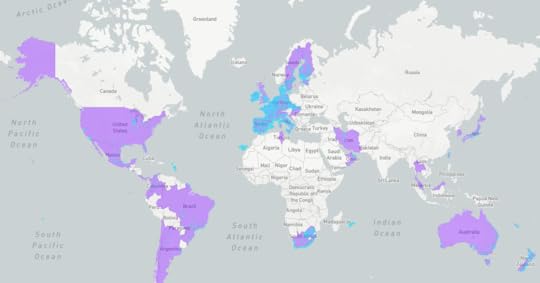Nicolas Windpassinger's Blog
December 3, 2018
What is series (#5): what is LiFi?
As explained in my IoT book Digitize or Die, wireless local area networks typically cover a range of about 100 to 1000 meters. In case you are new to the wireless technologies which are used for the Internet of Things (IoT) check out the image below for an overview.
LiFi (also Li-Fi, short for Light Fidelity) is a wireless communication technology leveraging the intrinsic capacities of LEDs (light-emitting diodes) to enable data transmission at high speeds. It is often compared with Wi-Fi due to its overlaps and the fact that both are WLAN technologies. However, there are important differences between Wi-Fi and LiFi. The main one is that LiFi uses light instead of radio frequency to transmit data.
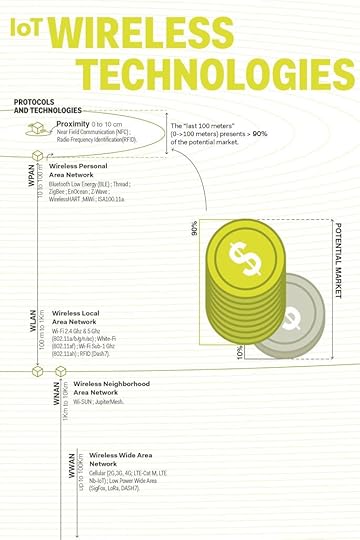
LiFi: how does it work?
LiFi uses (visible) LED light for the downlink and infrared light for the uplink. LEDs are switched on and off a million times per second. It’s through this modulation that LiFi enables data transmission.
LiFi technology is complementary to RF technologies such as Wi-Fi. Since light doesn’t travel through walls it is especially suited for specific use cases. These include use cases in, among others, smart buildings, critical facilities and industrial environments.
LiFi is not a formal standard yet. However, end 2017 the IEEE (Institute of Electrical and Electronics Engineers) announced the formation of the IEEE 802.11 Light Communications Study Group which is working towards global standardization for light communications and LiFi.
The standard will belong to the same family as Wi-Fi and other technologies: the IEEE 802.11 set of media access control and physical layer specifications for the implementation of wireless LAN communication (more about these layers in my article on the OSI reference model).
The usage and benefits of LiFi
Today, LiFi is already used in real-life smart building projects and applications where electromagnetic interference is not allowed or desired.
Schneider Electric, the company I work at, has worked with its partners to realize the award-winning Ampère e+ building which is one of the first office buildings across the globe where LiFi is already in place. This was done in collaboration with visible light communications pioneer Lucibel who collaborates with pureLiFi, a company that was co-founded by Professor Harald Haas. At a 2011 TED Global Talk Harald Haas, who coined the term LiFi, introduced the idea of “wireless data from every light bulb”.
In a white paper Lucibel defines LiFi as “a networked wireless communication technology transforming solid-state indoor lighting into a backbone for information”. It’s a recommended read in case you want to know everything about LiFi.
It’s important to know that in buildings LiFi has an important role in energy efficiency, the usage of IoT and the powering of connected devices whereby it’s a great fit with PoE or Power over Ethernet.
What role does LiFi play and why does it matter in a context of IoT?
LiFi is a perfect solution when you need connectivity in a zone where privacy and security are essential given the mentioned characteristics of light: it doesn’t travel through walls. In other words: the data ‘stays’ in a confined space.
In facilities or specific areas of facilities where radio waves are not allowed (some zones of hospitals, petrochemical or nuclear plants, facilities protected by regulations etc.) LiFi is the ideal alternative for Wi-Fi.
LiFi also helps solve congestion challenges in a time where ever more devices get connected. This can be the case in office buildings but also think about places where Wi-Fi networks typically don’t work well such as busy event locations.
On the level of IoT in facilities, LiFi is perfect because it uses an existing power capacity and thus opens new energy efficiency and management opportunities.
In the context of IoT it’s also worth noting that LiFi’s data transmission speed (end 2015 speeds were achieved up to 1 Gbps and up to 224 Gbps in a laboratory environment) is beyond what is needed to connect IoT devices such as thermostats and presence detectors. However, the density of potential connections under a LiFi light spot is such that many devices can connect to a single LiFi access point and aggregate their bandwidth requirements.
Other LiFi use cases include location-based services (for instance in retail), in-flight communication and entertainment, vehicular communication and underwater communications.
The post What is series (#5): what is LiFi? appeared first on Internet Of Things (IoT).
November 29, 2018
“Digitize or Die” is now a recommended book for students of the ESCP Business school
“Digitize or Die” is now a recommended book for students of the ESCP Business school:
ESCP Europe (French: École supérieure de commerce de Paris) is a European business school with campuses in Paris, Berlin, London, Madrid, Turin, and Warsaw. ESCP Europe is one of the most selective French Grandes écoles and referred in France as one of the “trois Parisiennes” (three Parisians)[1], together with HEC Paris and ESSEC Business School. ESCP is also considered as the world’s oldest business school.[2]
Accredited by the Paris Chamber of Commerce, ESCP Europe is one of the 76 business schools in the world to have obtained the triple accreditation of AACSB, EQUIS and AMBA.

I wrote the book as an education book, it’s great to see the knowledge going to students to help them accelerate the digital transformation of our economy.
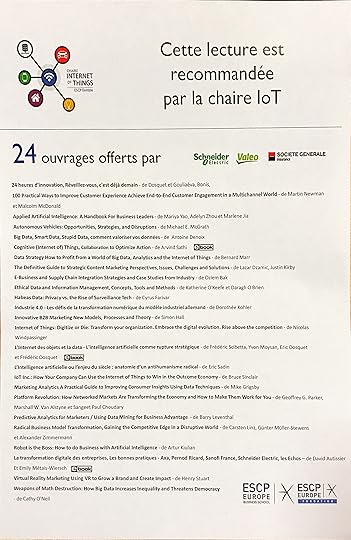
The post “Digitize or Die” is now a recommended book for students of the ESCP Business school appeared first on Internet Of Things (IoT).
November 23, 2018
How to series (#1): Digital Transformation: IoT & Financial Performance
In 2002, Capgemini Consulting published their online report, ‘How Digital Leaders Outperform their Peers in Every Industry’ after performing surveys on 391 companies and analyzing 184 publicly traded companies to assess their digital maturity. Importantly, the results were linked to their industry-adjusted financial performance.
Per Capgemini, digital maturity means to invest in technology enabled initiatives while at the same time, enabling digital transformation leadership.
They separated those two dimensions into four different categories and found that the companies that combine investments both in technology-enabled initiatives as well as the leadership capabilities outperform their peers.
Digitally mature companies derive more revenue from their physical assets (+9%), are more profitable (+26%) and have overall higher market valuations (+12%).
Another study, The Path to Digital Transformation (18), shows that digital transformation has the following positive impacts:
Four years are needed before there are financial results from the digital transformation.
The average net promotor score by customers will be 86% on average.
55 employees, on average, will have knowledge of digital capabilities.
On average, 45% of products will be ordered online.
Digital maturity leads to increased financial performance, higher customer and employee satisfaction.
Digitization might have different faces and might be understood differently when talking about technologies, organizations, channels and so forth. However, it is without a doubt a major contributor to financial performance, customer satisfaction and market valuation.
DIGITIZATION: TO BE OR NOT TO BE?
It’s always good to refer back to real cases of digital transformation. I chose 3 companies that went through huge digital transformation :
Michelin®
Nokia®
Kodak®
Each of them with very different markets, business models, channels but with a common challenge : how to transform themselves without breaking the existing machine ? How to transform the company from the edge without cannibalizing their current ‘analog’ business. some have succeed, some have not:
To be : MICHELIN®
Leading tire manufacturers such as Michelin, for example, are creating new business models to leverage the IoT to accelerate their transformation, leapfrogging Chinese commoditization manufacturers by moving from product-based business to a disruptive service-based business model. Their challenge is to transition from a tire provider to a service provider.
 The Michelin Fleet Service started in 2001 by renting tyres instead of selling them and providing maintenance to the fleet as part of this service base model. This enabled their customers to move an investment into a recurrent fee with added service such as maintenance as well as reducing their oil consumption and C02 footprint.
The Michelin Fleet Service started in 2001 by renting tyres instead of selling them and providing maintenance to the fleet as part of this service base model. This enabled their customers to move an investment into a recurrent fee with added service such as maintenance as well as reducing their oil consumption and C02 footprint.
In 2011 the model evolved to target large fleets that required important maintenance such as buses, mining trucks, and so forth. Unfortunately the model did not provide sufficient recurrent revenue and profitability to Michelin.
One of the challenge Michelin face was the needed culture shift of a very product-centric organization to a service based organization as well as moving from a centralized traditional structure to a decentralized transnational structure that is needed when changing a business model. One important aspect they managed to address was not only the business model shift but also how they leveraged their network of partners/Type and repair specialist in the endeavor.
They current numbers speak for themselves: more than 500 000 vehicles under contracts.
Not to be: NOKIA®
Looking at the past and at similar digital transformation is a good way to understand what might happen. An example is the story of Nokia. Are you aware of what happened to this company? Before 2007, Nokia practically owned the world of smartphones on the global market.
This resilient giant has managed to go through major transformations throughout its history since 1865: from rubber and paper to cable, from cable to mobile phones, from mobile phone to mobile internet. Nokia was one of the leading manufacturers in mobile technologies producing over 100,000,000 mobile phones in 1998. At its peak in 2007 Nokia controlled 41 percent of the market. By the end of 2015, Nokia’s market share sat at 15 percent, thanks to a horde of cheaper basic phones, according to data compiled by Strategy Analytics. In fact, by the end of 2016, Nokia has largely vanished from the smartphone market. So, what happened?
On March 13, 2014 at the INS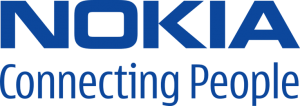 EAD conference Quy Nguyen Huy, INSEAD Associate Professor of Strategy and Timo Vuori, Assistant Professor of Strategic Management at Aalto University interviewed Olli-Pekka Kallasvuo, former CEO of Nokia on this subject. Their resume on Mr Kallasvuo feedbacks were clear: “The problem of Nokia, after all, seems frustratingly similar to those of many large companies such as Microsoft or Sony who could not develop high quality innovative products fast enough to match their rising competitors. As the companies grew larger and richer, each department became its own kingdom, each executive a little emperor, and people were more concerned about their status and internal promotion than cooperating actively with other departments to produce innovative products rapidly. (…) the overriding emotion felt by top managers and middle managers within the organization was one of fear. And yet, it wasn’t necessarily a fear of being fired which pervaded; it was more about fear of losing social status in the organization”.
EAD conference Quy Nguyen Huy, INSEAD Associate Professor of Strategy and Timo Vuori, Assistant Professor of Strategic Management at Aalto University interviewed Olli-Pekka Kallasvuo, former CEO of Nokia on this subject. Their resume on Mr Kallasvuo feedbacks were clear: “The problem of Nokia, after all, seems frustratingly similar to those of many large companies such as Microsoft or Sony who could not develop high quality innovative products fast enough to match their rising competitors. As the companies grew larger and richer, each department became its own kingdom, each executive a little emperor, and people were more concerned about their status and internal promotion than cooperating actively with other departments to produce innovative products rapidly. (…) the overriding emotion felt by top managers and middle managers within the organization was one of fear. And yet, it wasn’t necessarily a fear of being fired which pervaded; it was more about fear of losing social status in the organization”.
“Strategy is 5 percent thinking, 95 percent execution. Strategy execution is 5 percent technical, 95 percent people-related.” Olli-Pekka Kallasvuo, former CEO of Nokia.
Today, their market share has declined and continues to give up ground to competition from the iPhone and Android products. Nokia was so large that this drop would have been unthinkable at the time, yet they have not managed to evolve. Now it is desperately playing catch-up.
Mobile phone numbers will rise from just over 7 billion in 2015 to 8.6 billion by 2021, with connected device numbers passing those for mobile phones in 2018. During the same period, the number of IoT devices (connected cars, machines, utility meters, etc.) will more than triple between 2015 and 2021.
Not to be: KODAK®
Ignoring or minimizing the impact that IoT could have on your business might result in a shrinking market share, a smaller customer base, and falling profit margins. The risks associated with doing nothing or moving too slowly could be as significant as the loss of the company itself.
To illustrate, consider the sometimes-forgotten case of digital transformation, Kodak. Many people don’t remember that Kodak was the undisputed king of photography for much of the late twentieth century. Given the fact that Kodak’s core business was selling film, it’s not very difficult to understand how the last 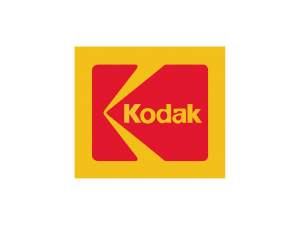 twenty years have been challenging to the well-established analog leader, with the fast and furious advent of digital cameras, smartphones, and cloud technologies.
twenty years have been challenging to the well-established analog leader, with the fast and furious advent of digital cameras, smartphones, and cloud technologies.
Chunka Mui , in his “How Kodak Failed” article published on January 18th 2012 on Forbes highlights the following: Barabba (head of market intelligence in 1981) had done a deep dive on the future adoption curves from the analog silver halide films versus the digital photography. He highlighted the fact that digital photography could possibly replace Kodak’s analog base business but also and importantly, that this would not happen overnight, and consequently the company had around 10 years to strategize and execute a digital transformation. Barabba sheds light on the fact that executive management was so worried about the digital photography threat, that they executed a strategy based on digital kiosks (10,000). Unfortunately, the team did not realize that the digital photography market would evolve towards home storage and home printing capabilities, and not remain dependent on photography services in these areas.
This example shows that the first ones to enter carry an important portion of the risks implied by testing unproven business models and carrying the R&D costs resulting from multiple available technologies that have not yet proven their relevancy. It also shows the importance of strategic timing that we will deep dive into a next post.
Kodak failed to embrace the new technology, simply put. CEO George Fisher told the New York Times that Kodak had “regarded digital photography as the enemy, an evil juggernaut that would kill the chemical-based film and paper business that fueled Kodak’s sales and profits for decade.”. Their failure was the result of their inability to truly embrace the new business models of disruptive change. Kodak failed at realizing “that online photo sharing was the new business, not just a way to expand the printing business”.
The company filed for bankruptcy protection in 2012, exited its legacy analog businesses, and sold off its patents. The fact that Kodak practically invented the digital camera and owned the patents on that technology makes this even more ironic.
Today the company has a market capitalization of roughly $635 million, which plummeted from $30 billion in the 1990s due to competition from digital photography.
YOUR EDUCATION IS THE KEY TO SUCCESSFUL DIGITIZATION
I very often meet people that are afraid to ask the questions that, in fact, everyone is looking to have an answer to such as:
What is the IoT?
What does it mean?
How can I benefit from it?
What are the technologies out there?
and so forth.
‘A fool thinks himself to be wise, but a wise man knows himself to be a fool.’ William Shakespeare
You might be finding a lot of commercial and marketing books but very often with a lack of strategic guidance, or anecdotal reference to what companies are facing. None of the technology books and blogs expanded on the IoT, beyond the pure technology element, in a way that would help companies understand how to transform, leverage themselves and supersede their competition.
I want to bring an answer to those questions through blogs, interviews and books.
Check up my website to know more: www.nicolaswindpassinger.com
The post How to series (#1): Digital Transformation: IoT & Financial Performance appeared first on Internet Of Things (IoT).
November 22, 2018
What is series (#4): what is LoRa(WAN)?
LoRaWAN is an open and scalable global LPWA network standard with freely accessible specifications, built upon the LoRa wireless modulation technology.
The LoRa protocol is a component in the physical layer of the OSI model and LoRaWAN is a data-link layer (medium access control) standard.
The CSS radio modulation technology for LoRa(WAN) was developed by French company Cycleo. Semiconductor manufacturer Semtech saw the possibilities of LPWAN early on, acquired Cycleo in and built the foundation of LoRa upon it. Semtech owns the LoRa Intellectual Property, develops LoRa technologies and hardware and licenses the intellectual property to companies such as Microchip and ST Microelectronics. This way there isn’t a single source in the entire LoRa and LoRaWAN ecosystem and value chain as I explain in my IoT book Digitize or Die.
The LoRa Alliance
Semtech co-founded the LoRa Alliance which gathers over 500 companies working with LoRaWAN and drives the success of the protocol to become the number one open global standard for secure, carrier-grade IoT LPWAN connectivity.
The LoRa Alliance provides a standardized framework and a certification program to guarantee interoperability, which is essential in the scope of IoT connectivity and data.
The members of the LoRa Alliance include major operators, cable companies, developers, solution providers, cloud players and hardware companies. The LoRa Alliance covers over 50 nationwide deployments across 150 countries and has over 100 LoRaWAN certified solutions for various IoT applications and use cases.
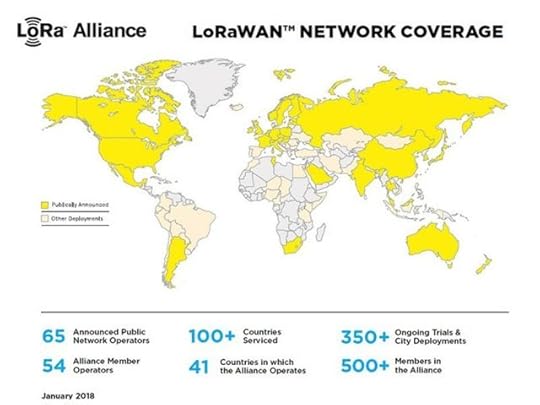
Characteristics and main features of LoRa and LoRaWAN
These use cases overlap with those mentioned in my post on LPWAN and my post on Sigfox, a competitor of the LoRa(WAN) ecosystem in the unlicensed band LPWA space.
Below are some key technical characteristics of LoRa and LoRaWAN
Just like Sigfox and other non-cellular LPWAN ecosystems, LoRaWAN leverages the Ultra Narrow Band (UNB)-sub GHz ISM band.
The cell capacity is around 40,000 objects/cell and has a throughput of between 300 bps to 50 000 bps.
In rural areas, the cell’s range is around 15 km and in urban areas, between 2 to 5 km. The stand by time for a 2.5Ah battery is about 20 years.
Security is embedded with a unique 128-bit Network Session Key shared between the end-device and network server and a unique 128-bit Application Session Key shared end-to-end at the application level.
Other features include full bidirectional support, firmware or application updates over the air and geolocation without GPS.
LoRaWAN as a complement to cellular LPWA technologies
LoRaWAN is positioned as complementary to cellular LPWAN which is why many operators offer both LoRaWAN and cellular technology LTE-M.
To understand this and the differences between LoRa(WAN) and cellular LPWAN below are some takeaways from an interview I conducted for my book with Ir. Jaap Groot, VP of Business Development at Semtech and Board Member of the LoRa Alliance.
Compared to cellular LPWA technologies LoRa is 5 to 10 times more power efficient in transmit and sleep.
Its peak power, which is important for battery dimensioning and cost, is about 5 times lower than that of its cellular companions.
The adaptive data rate, a mechanism to optimize data rates, airtime and energy consumption in the network, controls the transmission speed (Kb/sec) and makes the networks infinitely scalable as the objects connect only to those gateways they need to (the higher the bitrate the lower the distance).
A derived benefit is that LoRa can be deployed in very small gateways such as USB keys, set top boxes, routers and Wifi hotspots.
Due to the adaptive data rate there is no limitation regarding capacity: when capacity is needed operators deploy new gateways, indoor, outdoor or even as USB keys in routers.
The main difference between cellular LPWAN and LoRa is that there is no need for licensed spectrum whereby the subscription can be lower than cellular IoT and basically anyone can deploy a network.
Evolutions, innovations and network ecosystems
One of the strengths of LoRAWAN is the open LoRa Alliance ecosystem approach with a focus on improving the underlying technologies on the level of extending battery life, interoperability, geolocation, roaming and advancing the LoRaWAN protocol.
The Alliance is also key in adding new important partners whereby more countries and regions get connected. Sigfox also innovates and has its ecosystem, yet the approach is entirely different and there are important differences between both Sigfox and LoRaWAN. As always, the use cases and business needs are key in selecting the best option.
Quite importantly, innovative partners with multiple business models, some even crowdsourced, are making LoRaWAN available across the globe, often even in several countries at the same time since LoRaWAN is so open.
These various innovators conclude partnerships to keep LoRaWAN growing. In the UK, for instance, The Things Network and Digital Catapult’s Things Connected joined forces in June with a focus on extended coverage, companies getting started with IoT and innovative initiatives and use cases in practice.
Such initiatives make the charts on LoRaWAN coverage as the one shown in this post from the LoRa Alliance quickly outdated.
The post What is series (#4): what is LoRa(WAN)? appeared first on Internet Of Things (IoT).
November 12, 2018
Smart Homes: When Interior Design Meets the Internet Of Things (guest blog)
The Internet of Things (IoT) is bringing smart devices into the home – even before you move in. While interior design and technology are concepts that are not usually discussed, the onset of smart home gadgets is leading more designers to incorporate a digital focus on the elements of design. As the market for home interior rapidly grows, the industry is also making larger investments to develop innovative products by adopting IoT, with terms like ‘ITerior’ and “IoT-terior’ into their layout.
In fact, over 24 billion digital devices will be connected through IOT by 2020, according to research from Gartner. And while the idea of connecting household appliances like TVs, stoves, and refrigerators to the internet isn’t groundbreaking news, the potential of boosting the home decoration industry with smart technology is fueling IoT growth.
Turning Traditional Living Spaces into High-Tech Homes
With today’s busy generation, the demand for smart homes allows individuals to create a flexible work-life balance that’s useful for all ages. For example, the major home furniture and appliance giant, IKEA, recently launched a trendy smart lighting system that connects to tablets and mobile devices. Meanwhile, HiCan developed a smart mattress that combines the elements of entertainment, health management, and connectivity. When wearable tech and cooking appliances are combined, the ability to turn off the stove on your way to work can improve the levels of safety for families.
IoT Interior Services
Behind the trendy products in home décor, there are services that connect household appliances into an entire home control system. This service allows users to decorate their homes while establishing a new IoT environment. In fact, IoT-equipped homes are able to control heat via smartphone or virtual assistant, switch on/off lights with Wi-Fi, and start the pressure cooker from your smartphone
As last year’s major trend in IoT was about security and energy efficiency, 2019 seems to be focusing on the “how” of making your home relaxing through smart decoration. Thus, we can only expect to see how home construction and remodeling will be based on IoT functions in the near future.
Improving Your Budget in More Ways than One
The Internet of Things will affect how families interact with the space around them as well as what their appliances have to offer. The importance of data that is collected by IoT products can provide a variety of advantages, such as being able to detect when one section of the home is malfunctioning or in need of maintenance. This helps give insurance companies the confidence in your property decisions as well as the value of your home.
Not only will incorporating IoT in your home design become affordable, but it may also save you money due to the use of energy-efficient technology. With new attempts of bringing IoT and interior design trends onto the same platform, interior décor will not only provide aesthetics but also offer smart functions that make the home comfortable and convenient. After all, smart homes shouldn’t be “smart” for the sake of it, but to improve the everyday lives of consumers.
The post Smart Homes: When Interior Design Meets the Internet Of Things (guest blog) appeared first on Internet Of Things (IoT).
October 31, 2018
Why Internet of Things (IoT) is at its inflection point
The Internet of Things is disrupting all businesses, including the leaders. Since I launch the book, I have had a lot of discussion with leaders telling me: “I need to go Digital…. but I don’t know how… ”
The IoT is already transforming numerous markets and companies such as manufacturing companies that have been very successful in the Analog era, and that now must transform themselves in order to survive in the coming decades.
Making sense of these changes and, more importantly, understanding how to leverage them in order to grow head and shoulders above the competition should be one of the priorities of today’s Analog leaders.
The IoT will connect everyone and everything into a seamless network, which Jeremy Rifkin calls the “Intelligent Third Industrial Revolution infrastructure—the Internet of Things”. In his last book “The Zero Marginal Cost Society“, he highlights the fact that the IoT will “usher in a fundamental reordering of human relationships, from hierarchical to lateral power, that will impact the way we conduct business, govern society, educate our children, and engage in civic life”.
A TASTE OF “DÉJÀ VU” ?
On the opening day of the World Economic Forum in Davos, in 2015, John Chambers, Executive chairman of Cisco Systems, speaking at a session entitled “The New Digital Context”, stated, “I’ve seen this movie before. Today we are at an inflection point. Take what happened with the Internet in the 1990s, multiply it by five to ten-fold and that’s what you’re about to see and the benefits are going to be seen by every single person. In short what you’re going to see is every company, every country, every citizen, every home, every car, every wearable becomes digital. That information flow is going to allow you to change things.”
As a powerful indicator of this era, the sum of all data created in the next few years will be at least ten times more than the total of all data generated up to this point, jumping from around 4.4 zettabytes in 2013 to 44 zettabytes by 2020. IoT is accelerating the digital transformation which started in the year 2000.

Technologies are evolving laser fast, but have not yet established their “rules of the game”.
That which happened to digital cameras in the 1990s and with the internet in the beginning of 2000 is what is happening to the IoT right now.
Why IoT is at its inflection point ?
I think that there are mainly 2 reasons that explain why IoT is at its inflection point:
Cost of technology is falling

2. Cost of connectivity and bandwidth are also falling: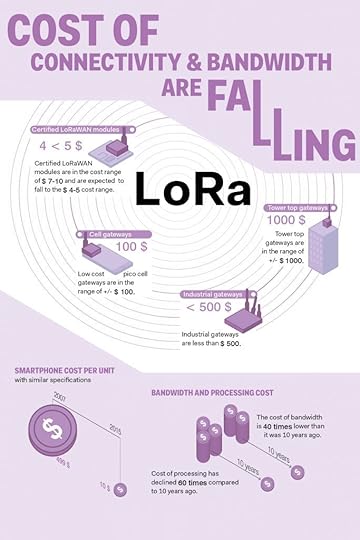
How to benefit from this inflection point, what are the Threats and Opportunities ?
A survey done by Gartner, showed that 91 percent of the surveyed IT professionals had doubts about their roles in their organization’s digital transformation. However, 59 percent added that their IT organization was unprepared for the digital business of the next two years:
A recent study also showed that the biggest threat to Digital Transformation is in fact more internal than external:
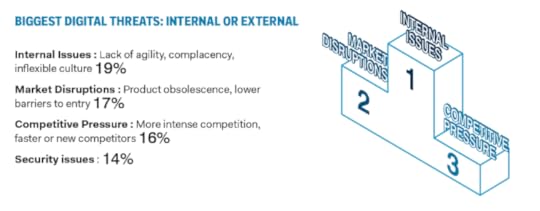
As of today, there are opportunities for both existing and new players. Digitization enables technology companies to compete with historical analog businesses.
You can choose to ignore the opportunities, but you will not be able to sidestep the repercussions of the IoT.
Don’t be misled by the self-declared technology gurus that the digital revolution is simply yet another evolution of technology. The Internet of Things is an industry-specific buzzword and almost 90% of the population have no idea what it means.
Time lost is never recovered
[image error]
The risks associated with doing nothing or moving too slowly could also impact the ability of your company to seek new financing which would allow for a strong come back or to catch up with other players that have better managed to pivot and re-think their operations, their people, and the way they do business.
You might believe the IoT is growing slowly, giving you plenty of time to strategize and transition your business to this new paradigm. However, the number of things—smart devices of all types—connected to the Internet is growing exponentially. Gartner predicts that the number connected will increase from 6.4 in 2016 to 20.8 billion by 2020.
Unfortunately, time is a scarce resource, even more so when technologies, market, and competition acceleration reduce the time left to react and adapt to the new rules of the game.
The first thing anyone tackling the Internet of Things should start by his/her education.
As stated previously the IoT is still a buzz word but the rules of the games are beginning to be written and we are very close to the inflexion point; so now is the best time to educate yourself. Learn the rules of the game
Your priority should be to learn the rules of the game. If you don’t know the rules of the game, if you don’t spend time learning them, how can you expect to win?
#1: Understand the underlying technologies
#2: Understand the use cases, the emerging business models, the go to market/channel and ecosystem required
#3: Keep learning: go to the source of updated information such as IoT events and conference, books, blogs and so forth
I went through this path and initially, I did not set out to write a book. I had merely wanted to find such a book, but instead discovered it did not exist. None of the technology books and blogs expanded on the IoT, beyond the pure technology element, in a way that would help companies understand how to transform, leverage themselves and supersede their competition.
The post Why Internet of Things (IoT) is at its inflection point appeared first on Internet Of Things (IoT).
October 25, 2018
Connected Cooking: Three Ways IoT Will Revolutionize Smart Kitchens
This a guest blogpost from Lucy Kingsley:
Everything from a tiny magnet to a refrigerator door can be connected to the internet. Taken from the last Smart Kitchen Summit this week, appliance companies such as Gourmia, are set out to develop smart IoT tools for kitchen appliances. Yet, this is only the beginning of how cooks can rely on easy-to-use tools from sous vide to juicers to become as smart as possible.
IoT and household devices: Making your home kitchen smarter than ever
Today, we’re living in an age where measuring devices are Bluetooth-enabled and refrigerators come with WiFi and USB adaptors. IoT promises that smart tech features like Google Home and Amazon’s Echo provides access to music, receive daily information, and sets timers without a single touch of a button. In fact, smart thermostats can help turn on the heat before we arrive home while lightbulbs can automatically turn on, even when we’re out. Meanwhile, home security offers live monitoring and the ability to talk to house visitors straight from your phone.
IoT to reduce waste and lower costs
Approximately 1.3 billion tons of food goes to waste every year, according to the Food and Agriculture Organization of the United Nations. With the growing cost of produce, IoT-enabled inventory tools help homeowners keep track of their home inventory easily. For example, IoT-enabled ovens help reduce raw material consumption by up to 10% and lower the use of energy consumption by up to 28%.
IoT provides digital assistance
While digital assistance is found in a variety of smart home appliances, voice-activated tools are useful when your hands are covered in flour or measuring ingredients. Whether you’re converting ounces to gallons or deciphering a new recipe, smart-talking gadgets are becoming the ideal sous chefs. Not to mention, the latest crock-pots and digital thermometers are designed to provide temperature graphs and adjust cook times for better results
So, should you consider these upcoming IoT technologies in your own home kitchen? While you could make the argument that IoT in the house is a passing trend, our kitchens will gradually focus on becoming a high-tech, smart driven lifestyle that will change the way we live.
The post Connected Cooking: Three Ways IoT Will Revolutionize Smart Kitchens appeared first on Internet Of Things (IoT).
October 16, 2018
Winner in the 2018 IAN Book of the Year Awards!
I am very pleased to announce that Digitize or Die, is a winner in the 2018 IAN Book of the Year Awards!
Ian is the Independent Author Network; they organize every year an international contest open to all authors with 36 fiction and non-fiction categories.

The judges are experienced reviewers, authors, publishers, and editors. Awards are based upon various criteria and the judges’ decisions are final. >Click to Meet the Judges
When judging completed, Digitize or Die, was selected as a finalist in one category: “Business/Sales/Economics.”
The post Winner in the 2018 IAN Book of the Year Awards! appeared first on Internet Of Things (IoT).
October 12, 2018
What is series (#3): what is Sigfox?
When speaking and sharing with a lot of you, I decided to start a”What is?” series of blogs to share the knowledge that is out there and bring some insights. The first post is about Sigfox.
Sigfox is one of the leaders in the market of non-cellular LPWA network or LPWAN wireless communication technologies. The company was founded in 2009 in France.
Since IoT adoption grows and the role of connectivity and data is essential both Sigfox and the other major player in the unlicensed band LPWA space, LoRa, have been growing rapidly in recent years.
As mentioned in my IoT book Digitize or Die, the wireless landscape is made up of many acronyms and protocols. To begin classifying the most known technologies and protocols, we will use network range as a first filter. A network range is typically categorized into 5 classes:
Proximity, body area networks – covers all wearable devices (including implants, surface mounted on the body, etc.)
WPAN: Wireless Personal Area Network – covers a range of about 10 meters to 100 meters
WLAN: Wireless Local Area Network – covers a range of about 100 meters to 1000 meters
WNAN: Wireless Neighborhood Area Network – covers a range of about 1000 meters to 10 km
WWAN: Wireless Wide Area Network – covers a range above 10km (as big as the entire globe of needed)

The aim of Sigfox is to build the first global public LPWA network. You could compare Sigfox in a sense to a mobile operator, yet for a very specific type of connectivity: lower power, wide range and IoT-related only. The company calls itself the ‘global communications service provider for the Internet of Things’.
Sigfox has benefited from its first-mover position in Europe and in 2017 Sigfox, which is both the name of the company and of its LPWAN technology and offering, accounted for most public LPWAN connections across the globe as LPWA connections research found.
Sigfox has a very specific approach whereby it only offers public LPWAN possibilities. While the number of private LPWAN connections has been higher so far (and dominated by LoRa and LoRaWAN, the topic of my next post), by 2023 public networks will capture over 70% of LPWA connections (cellular and non-cellular) according to ABI Research.
Characteristics of the Sigfox network
Because of its ‘global IoT service provider’ approach Sigfox works with companies, of which several are investors, that dispose of infrastructure (essentially towers for its Sigfox antennas). The business model of Sigfox, which is privately owned, requires a large ecosystem of partners, including the ‘Sigfox network operators’, and high investments to keep rolling out globally and to innovate.
SigFox uses the Ultra Narrow Band (UNB) – sub GHz ISM band with radio frequencies ranging from 862 to 928 MHz (depending on the region). A good video they posted on their website: https://www.sigfox.com/en/sigfox-iot-...
Sigfox devices use small messages (12 bytes uplink and 8 bytes downlink) with up to 140 messages per day. A Sigfox gateway can handle 1.3 million messages per 24 hours maximum, thus if each object transmits 10 messages per day this would be 130K objects.
The network redundancy is achieved by overlapping cells coverage of 3 gateways. As the spectrum usage is not optimized this mean any message use the spectrum available to 3 gateways and thus its cell capacity is approximatively 130K / 3 = 43K objects/cell.
A cell’s range, in rural areas, is between 30 to 50 km and in urban areas between 3 to 10 km. The standby time for a 2.5 Ah battery with SigFox access is about 20 years.
Sigfox innovations and use cases
Since my book was published Sigfox has announced several new features and services which are key for its development:
The Sigfox Monarch cognition service enables more use cases as it enables devices to recognize and manage radio frequency changes autonomously, depending on the region the device is in.
Sigfox has also been working on IoT interoperability whereby IP on LPWAN devices would enable to complement cellular LPWA technologies, such as NB-IoT.
Traditionally Sigfox has been mainly used in typical non-cellular LPWAN IoT use cases, from smart city applications and smart buildings to smart agriculture, smart homes and manufacturing.
The mentioned ‘technical specifications’ help you see in which use cases it fits best. Yet, with the Monarch service Sigfox has broadened the (potential) number of use cases, for instance in logistics and supply chain management where asset tracking and maintenance beyond local applications is now easier. A typical example is asset tracking in shipping.
On top of the core Sigfox IoT connectivity service, Sigfox also offers solutions such as Monarch, Sigfox Geolocation and an onboarding process service for partners.
Early 2018 Sigfox said it is available in 45 countries with coverage for little over 800 Million people.
The post What is series (#3): what is Sigfox? appeared first on Internet Of Things (IoT).
January 16, 2018
The importance of leadership and middle management for IoT (Guest blog)
Recent blog I did for IoT News: https://www.iottechnews.com/news/2017...
Even though the digital transformation has been building up for over a decade, most businesses have yet to recognise it as a high priority. This is especially true of larger corporations with solid, apparently unassailable channels and markets.
It is true that some businesses will not be impacted by what IoT brings to the table. But are you truly confident, as you read these sentences, that your business is immune to the IoT revolution?
Many leaders may not see the threats to their business and are blinded by their current analog profitability. Our brain is ‘inherently lazy’ and will always ‘choose the most energy efficient path’ if we let it, writes Tara Swart, a senior lecturer at MIT, in her book Neuroscience for Leadership. “[The brain’s] need [to survive] focuses attention on the sources of danger and on trying to predict where the next threat will appear, on escape or full-frontal battle rather than on an innovative or creative solution, on avoiding risk rather than managing it towards a new suite of products, market or way of doing business,” Swart writes.
If leaders don’t see the threat and opportunities of the IoT and fail to understand how they can leverage that for their company’s benefit, then they are in danger of becoming yet another case study like Kodak, Nokia, and Polaroid.
On the other side of the coin, there are leaders who fully acknowledge that there are some risks and that those might be potentially deadly to their business. They struggle to raise the urgency of change and the associated orchestration among their employees. When properly tackled, digital transformation can ignite a sense of purpose among your teams, and more importantly raise the overall satisfaction and therefore increase buy in from them which often increases productivity. Studies show that when a clear digital strategy is being established and shared with employees, the satisfaction of those employees raises from 10% to nearly 90%.
The importance of leadership
John Kotter, professor of leadership, emeritus, at the Harvard Business School, author of numerous books on leadership, highlights this importance of leadership and the difference between leadership and management when dealing with change management:
Management gets the regular work done well, reliably and efficiently, even in exceptionally large and complex systems
Leadership sets the vision and the associate strategy. They have the capability to energise their troops to trigger innovation despite the recognised changing problems and opportunities.
Both are important when dealing with a digital transformation strategy in a complex environment and organisation. Leadership is a key success factor when dealing with market niche or in a world where opportunities and technological trends can change greatly. Good management is a key success factor in large organisations operating in protected markets and environments that changes little.
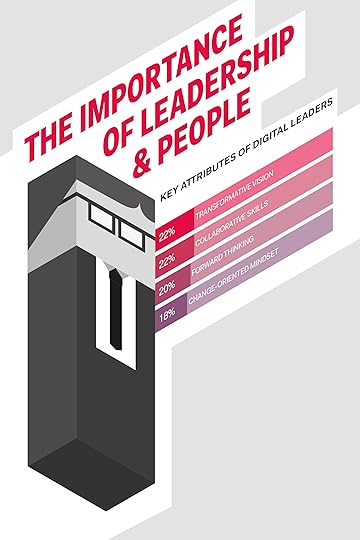
The importance of digital mine canaries
Another important aspect when dealing with people in a digital transformation environment is that there is often someone who will understand the necessary steps to digital transformation before the rest of the peers and thus challenge the status quo. Those within the corporation who recognise the need for change often face marginalisation from the minds of the ‘analog’ leaders and scepticism from peers.
Carl Yankowski joined Polaroid in 1988 as vice president in charge of the business imaging, US consumers and industrial marketing.
He quickly identified the necessity for Polaroid to embrace the digital transformation by acquiring electronic imaging technologies. Unfortunately, MacAllister Booth, his CEO, vetoed the plan and gave clear ‘analog’ feedback, “Anyone who says instant photography is dying has his head in the sand.” Even the next CEO, Gary DiCamillo, had a very similar analog approach. He stated in 2008 at a Yale interview that “People were betting on hard copy and media that was going to be pick-up-able, visible, see able, touchable, as a photograph would be.” A couple of years later he analysed the situation: “We knew we needed to change the fan belt, but we couldn’t stop the engine. And the reason we couldn’t stop the engine was that instant film was the core of the financial model of this company.” This is very similar to Fujifilm’s model; the major difference is that Fujifilm’s management made a clear strategic choice to cannibalise their own market in order to enable the transformation to happen and build a longer term success.
Such an environment unleashes the opportunity to get early warning detection systems for your business, much like a canary in a coal mine. So, keep in mind that the canaries are not the problem. Rather, it’s the way you, as a leader and as a company, leverage them to create value for your customers, your channels, your company and its employees and the shareholders.
Carl Yankowski was Polaroid’s canary, and unfortunately for them, he was ignored.
Polaroid could have been a pioneer in digital photography if the leaders had embraced original ideas and set a vision that included the understanding that failing fast, protecting teams that challenge the status quo, embracing culture change can create the conditions for successful digital transformation. Unfortunately, Polaroid failed in those areas mainly because they did not have the conditions for its employees to embrace change and accelerate the needed digital transformation. This example highlights the importance of the people side of digital transformation and in particular the role of middle management when dealing with change and adaptation of organisations.
The importance of middle management
When dealing with digital transformation, leadership must first set a vision and clearly state and envision the result of the changes that are necessary. But vision and leadership is not enough. The Polaroid case clearly shows that even though they had performed thorough market research, even though they could have acquired the technology and even though they had leaders that had perceived the opportunity behind the risk, they did not realise the importance of middle management in digital transformation.
George Caspar Homans was an American sociologist (August 11 1910 – May 29 1989), founder of behavioural sociology and the Social Exchange Theory. He expressed in his different publications the importance of middle status of individuals in social organisations as well as their capabilities to absorb and drive creativity.
He considers that any hierarchical social organisation is constituted of:
‘Low status individuals’: individuals do not fear status loss as they feel that they do not have anything to lose. Status can be defined as respect, honour, influence on other groups with the associate benefits such as credit, control, attention, influence as well as material benefits.
‘High status individuals’: interestingly high-status individuals have a very similar reaction to their social status in that they are not afraid of losing social esteem, but not because of the same reasons. The consequence of being at the top of the social pyramid are the associate advantages such as ego satisfaction, financial freedom and well-being which in turn gives those individuals a lot of freedom in their everyday life and decisions.
‘Middle status individuals’: Those individuals are on the opposite side, when talking about fear of losing status, of both the low and high-status individuals. The threat of status loss is the highest in this category of individuals as they are respected and can influence the low status individuals while at the same time dealing with the high-status individuals that are more respected and influential to the whole group.
If you apply those categories to a standard medium size company, you could categorise the groups as follows:
‘Low-status individuals’: skilled or semiskilled workers, administrative personnel, transversal function with low influential power, etc.
‘High-status individuals’: executive teams and their associate N-1. Transversal functions with influential power.
‘Middle-status individuals’: middle management that refer to high status individuals to seek for approval and or final decisions, etc.
Middle management and innovation
Recent studies seem to show that when dealing with innovation and transformation and change in a social organisation such as a company, the middle status individuals will be more concerned than other groups to follow the rules at the cost of creativity and innovation. From an innovation point of view (organisational, R&D, process and so forth), being criticised and negatively evaluated for suggesting creative ideas may be particularly salient to middle status individuals. Middle status individuals tend to be less creative than those with high or low status but on the other side they can boost the group’s performance by focusing on productive tasks and filtering out irrelevant information.
High status individuals seem to have more willingness to risk the expression of creative ideas due to the fact that they are well established as high status individuals and do not fear losing the position. Interestingly Michelle M. Duguid and Jack Goncalo in their article “Squeezed in the Middle: The Middle Status Trade Creativity for Focus” seem also to show that, even if the high-status individuals’ creative ideas are objectively not more creative than ideas from the middle or low status individuals, their status and associate confidence makes them more confident to persuade the rest of the group.
In the Polaroid case, middle management didn’t embrace the high-status individuals’ beliefs and because of that they were pushed to the side. This caused major issues with innovation, digital transformation, cohesion and keeping digital talents in the company.
Analog company leaders willing to embrace the IoT should help the company’s middle management to understand the goals and outcomes, as well as the risks and threats to the existing business.
Setting a vision and giving a sense to the mission is not only about defining what needs to be done but also about creating the environment in which employees can challenge the status quo such as the business model, processes, products and services and to the corporation itself and creating enhancements to those.
Explaining the ‘why’ to middle management and more importantly enabling innovative action in the edge of the ‘mothership’ creates the environment for change and adds a sense of urgency and accountability amongst the middle status individuals.
Editor’s note: This is an extract from Digitze or Die, by Nicolas Windpassinger. You can find out more about Digitize or Die and purchase it here. All benefits from the book will be donated to the Alzheimer’s Association and Fondation de France. You can learn more about the book here.
The post The importance of leadership and middle management for IoT (Guest blog) appeared first on Internet Of Things (IoT) hub.

